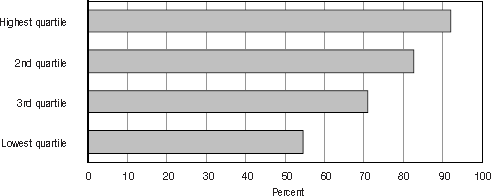
Differences in the penetration and use of various ICTs, both within and across countries, are well documented. Studies of the “digital divide” (U.S. Department of Commerce, 2002; OECD, 2001 & 2004; Sciadas, 2002) have both identified and analyzed factors that influence Internet connectivity and use of ICTs, whether at the household or individual level. While income is often a key determinant, other factors have also been shown to exert an independent influence. These include education, age, gender, residential location (urban vs. rural) and even family type.
Figure 5.5
Source: International Adult Literacy and Skills Survey, 2003.
Figure 5.5 shows the relationship between household income and access to a computer at home. The pattern is similar for Internet access. Confirming previous findings, use of computers and Internet connectivity vary substantially by income. In Canada, computer penetration among individuals in the highest household income quartile is nearly universal (92 percent) but only slightly over half of those in the lowest income quartile (55 percent) have access to a computer at home. Individuals living in low-income households may therefore face computer-related learning disadvantages (Felstead, Duncan and Green, 2002) and may not access health, government, and other information on the Internet. It should also be noted that the gaps in access in the lower income quartiles are larger than the gap between the top two income quartiles. In other words, as income declines, the gap in access widens. This pattern is not unique to Canada but also observed in other countries participating in the ALL study (Veenhof, Clermont and Sciadas, 2005).
An insight into the relationship between use of ICTs and other competencies can be obtained by comparing the literacy proficiency of respondents who say they use ICTs and those who do not. In Canada, there is a 75-point gap between computer users and non-users on the prose literacy scale with a range from 0 to 500 points (Veenhof et al., 2005).3 Thus in addition to a digital divide, non-users may also face a literacy challenge. In a separate Canadian study, findings also show a positive relationship between access to home computers and reading achievement among 15 year-olds (Bussière and Gluszynski, 2004).